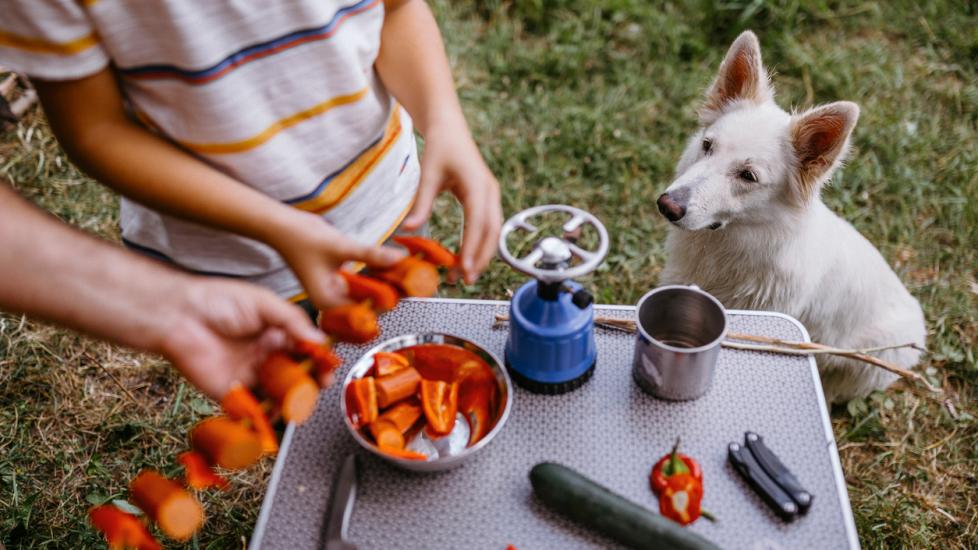Can Dogs Eat Bell Peppers?
NOTE: Always check with your veterinarian first before giving your dog any new foods, especially “people foods.” What might be OK for one dog might not be good for your dog, depending on multiple factors, such as their age, health history, health conditions, and diet. Dogs on prescription diets should not be fed any food or treats outside the diet.
Wondering if dogs can eat bell peppers? Good news—like many types of vegetables, bell peppers are on the safe list for dogs to eat. These colorful veggies are packed with vitamins and minerals that can be beneficial to your pup's health as well as your own.
While sweet bell peppers are generally safe for dogs to eat in moderation, not all peppers are created equal. Many other peppers, including jalapeños and chili peppers, contain a chemical called capsaicin that can be harmful for your hound. But since bell peppers don’t have the spicy capsaicin component, they’re safe for dogs to eat.
Keep reading to learn more about how bell peppers can be a healthy addition to your dog's diet.
Are Bell Peppers Good for Dogs?
Incorporating sweet bell peppers into your dog’s diet can provide a boost of vitamins and minerals. Plus, they’re high in fiber and low in calories, making these a great treat alternative for pups who may need to lose a few pounds. Bell peppers are a good source of vitamins A and C, which can help improve your dog’s immune system, eye health, and skin/coat.
Generally speaking, there’s no difference between the color of a bell pepper and how safe it is for dogs to eat. All bell pepper colors (green, red, yellow, and orange) are fine for dogs to consume in moderation, because each contains zero levels of capsaicin.
But the same does not apply to other types of peppers. Hot peppers like jalapenos, chili peppers, and cayenne peppers all contain capsaicin. Eating peppers that contain capsaicin can cause your dog to experience digestive upset, vomiting, and diarrhea. So don’t feed your dog hot peppers or food that has been seasoned with spices containing capsaicin, like chili powder.
How to Safely Prepare Bell Peppers for Dogs
It’s no sizzling steak, but if your dog is interested in a bite of bell pepper, here’s how to safely share this garden favorite.
Start by removing the seeds and stems, then slice the pepper into small pieces. You can opt to cook or steam bell peppers to soften the skin if your dog has trouble eating them, as raw bell peppers may be more difficult for dogs to chew or digest. Just avoid any extra ingredients that can make your pooch sick, like garlic, onions, salt, oil, or butter.
As with any new food, moderation is key. Start by adding bell peppers to their diet in small amounts as a treat or food topper, and go from there. Remember that veggies alone should never replace your dog’s regular dog food diet and should be given in moderation. As you introduce bell peppers to your dog, monitor their reaction for any signs of digestive upset or food allergy.
How Many Bell Peppers Can Dogs Eat?
While bell peppers can be a healthy addition to your pup’s diet, feeding large amounts of bell peppers to dogs can lead to stomach upset, diarrhea, or vomiting. If your pooch gets sick after eating a bell pepper, stop feeding it to them.
With any new addition to their diet, it’s best to consult with your vet to determine how much bell pepper is safe for your dog to eat. They can make recommendations for your dog based on their individual dietary needs. Here are some general portion guidelines to follow if you’re introducing bell peppers to a healthy adult dog:
-
Extra-small dog (2–20 pounds) = one or two small pieces (about 1 tablespoon total)
-
Examples: Yorkies, Chihuahuas, Pomeranians, Pugs
-
-
Small dog (21–30 pounds) = less than 1/4 bell pepper (three or four small pieces)
-
Medium dog (31–50 pounds) = 1/4 bell pepper (up to eight small pieces)
-
Examples: Basset Hounds, Border Collies, Australian Cattle Dogs
-
-
Large dog (51–90 pounds) = 1/2 bell pepper or less
-
Examples: Pit Bulls, German Shepherds, Labrador Retrievers, Australian Shepherds
-
-
Extra-large dog (91+ pounds) = 3/4 bell pepper or less
-
Examples: Newfoundlands, Bernese Mountain Dogs, St. Bernards, Great Pyrenees
-
What Other Vegetables Can Dogs Eat?
Here are some vegetables that are generally considered safe for dogs to eat. As with any new food—even the safe, healthy kinds—introduce veggies to your dog’s diet in moderation and watch for any signs of digestive upset.
-
Broccoli: Source of Vitamins A, C, and K, as well as potassium and fiber (but too much can cause gas)
-
Carrots: Source of vitamins A, K, and C, as well as potassium
-
Cauliflower: Source of Vitamins A, C, and K, as well as potassium and fiber
-
Cucumbers: Mostly water, cucumbers are hydrating and low-calorie
-
Lettuce: Vitamins A and K, as well as some minerals like potassium
-
Peas
-
Spinach: Vitamins A, K, and C, as well as potassium
-
Tomatoes: Vitamins A and C, though some dogs may be sensitive to large quantities
-
Zucchini
Remember that not all vegetables are safe for dogs to eat. Some veggies, such as onions, garlic, and chives, should be avoided because they are toxic to dogs. Always talk to your vet before introducing new foods to your dog's bowl, as they may have recommendations that take into account your pet’s health, age, and weight.
Featured Image: iStock/mixetto
